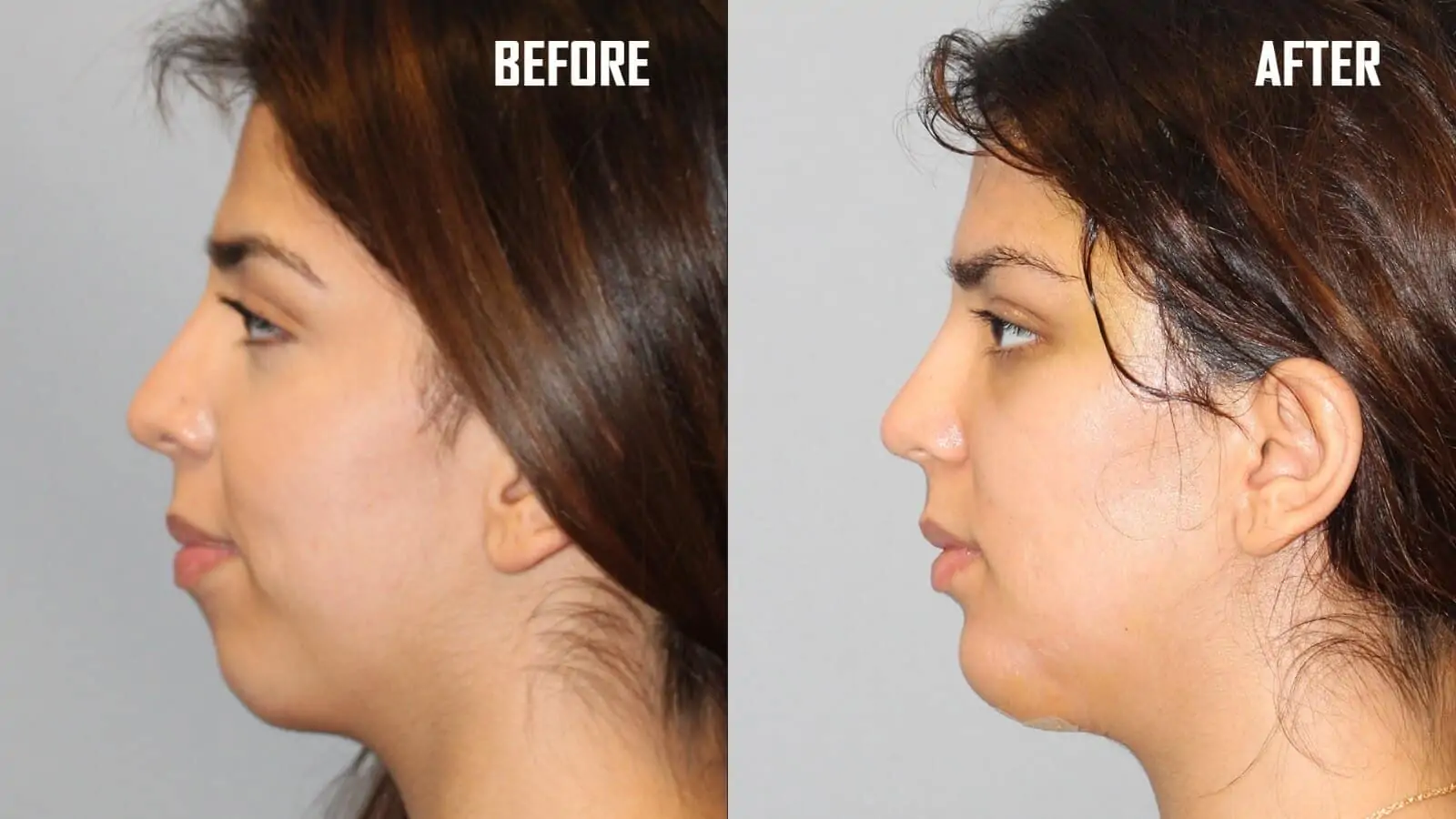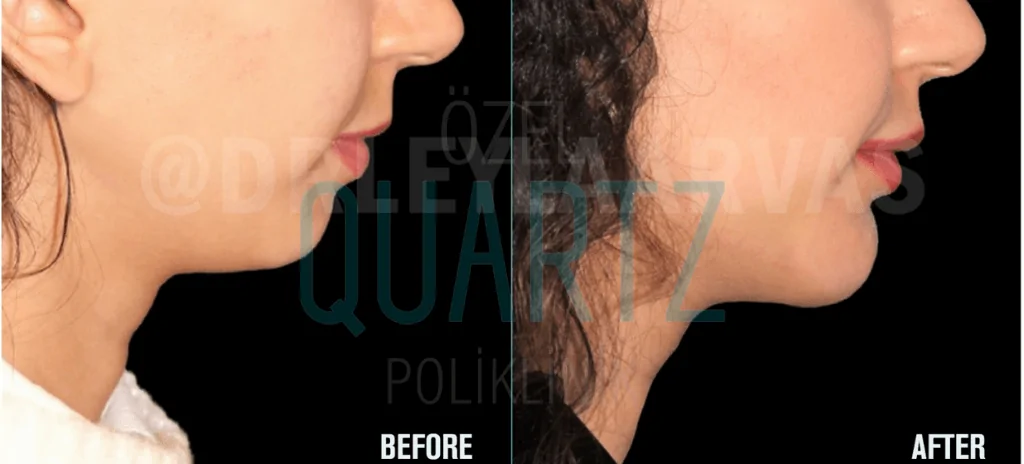 The chin is the most important aesthetic appearance feature in the lower face appearance.
The chin is the most important aesthetic appearance feature in the lower face appearance.
The chin and nose together determine the shape and profile of the entire face. As we get older, bone density decreases and the fat tissue on the face melts and weakens.
This causes the chin to appear retracted, resulting in a smaller or “weaker” appearance. A weak chin can cause the nose to appear forward, the upper teeth to protrude, and the chin and neckline to appear indistinct.
Chin augmentation surgery is one way to correct this appearance. Chin implants increase the size of the chin and increase its definition.
Chin implants, also called chin augmentation or mentoplasty, are used to strengthen the jawline. The dimensions of the implants are chosen to provide patients with symmetry and proportion with the rest of their face.
As a result, a defined jawline is usually created from the profile and full face, and the chin becomes prominent.
Chin implants have become popular because they provide permanent results. It improves the profiles while maintaining the natural appearance of the patient’s face. They also restore the symmetry and upper-lower balance of the face.
How Is Implant Selection Made in Chin Augmentation?
The latest technological developments have made the materials used in plastic surgery long-lasting and more natural looking. As a result, the safety of chin augmentation and the use of implants has been increased. In a small or retracted chin (microgyne), a wide variety of implants can be used.
Chin implants are available in several styles, in many shapes and sizes to match the face shape and desired feminine or masculine appearance.
Each chin implant is available in a variety of sizes, thicknesses and projections. After measuring the mandibular bone to select the perfect chin implant size, that fits the contour of your jaw.
If you tell your doctor what kind of appearance you want, the most compatible implant will be selected for chin augmentation..
How is Implant Placed in Chin for Augmentation?
Chin augmentation surgery takes about 30-45 minutes. Chin augmentation surgery, which is a minor surgical operation, can be performed under general anesthesia or local anesthesia or intravenous (IV) sedation.
The incisions made for placing the implant, called mentoplasty incisions, are usually made either in the mouth where the gums and lower lip intersect, or under the chin along the natural fold line.
After the implant is placed properly, it is closed with sutures. Some stitches dissolve on their own after a few weeks. If you have non-dissolving stitches, your doctor will remove them during your checkups.
Am I Suitable for Chin Augmentation?
 Our profile in the mirror gives us information about whether our chin is positioned correctly.
Our profile in the mirror gives us information about whether our chin is positioned correctly.
For this, by examining your profile photo, draw an invisible line from upper lip to lower lip, if your chin is behind the line, this is an indication that your chin is smaller than normal or behind.
Chin augmentation surgery is performed for both men and women and corrects:
- If the chin seems too small for the face
- If the chin is pulled back due to natural aging
- chin asymmetry
- Deterioration of jaw appearance caused by birth defects or trauma/injury
- Fat accumulation under the chin
- Combined chin-neckline due to chin deficiency
- double chin
- Disproportion between the upper and lower areas of the face
- Premature aging of the lower face and neck
The chin dimple originates from the soft tissues of the face and is not attached to the bone. Even if the chin implant is placed, its appearance may not change, in which case dermal fillers or fat injection are preferred.
Consultation Before Chin Augmentation
During a chin augmentation consultation, your doctor may order a series of X-rays and look for any bone pathology that could affect the outcome of the surgery.
Your doctor will then take measurements to determine the degree of enlargement of the chin. This will also reveal asymmetries. It can also use digital image analysis to determine the degree of size and shape you want for the shape, size and appearance of your face.
After completing the analysis of the digital images, your doctor will discuss their recommendations regarding implant shape and size. The implants used are custom made with the latest technology and the operation is planned using the latest placement techniques.
Which Implants are Used in Chin Augmentation Surgery?
State-of-the-art chin implants are usually made using alloplastic materials with high biocompatibility. These materials are silicone, Gortex or high density porous polyethylene.
Gortex and silicone are the two most commonly used implant materials.. Since polyethylene implants have a porous structure, they can be a good choice for larger implants. These implants also promote tissue growth and prevent implant displacement.
What Are Chin Implant Options?
![]() Mid Chin Implants: They are offered in the original form of a chin implant and move the chin forward to varying degrees.
Mid Chin Implants: They are offered in the original form of a chin implant and move the chin forward to varying degrees.
Anatomical Chin Implants: Provide mild or moderate chin augmentation of the anterior part of the chin. It is in the form of two 45 degree wings and conforms to the shape of the anterior mandibular bone for smoother lines of the implant.
Extended Anatomical Chin Implants: Used to further develop the jaw line and create a more angular or square jaw structure. They are long-winged anatomical implants. The wings taper along the ridge of the lower mandible from a rounded appearance to more define the mandibular bone.
Mandibular implants: Used to widen the jaw angle and increase the definition of the jaw line. This type of implant is often used with anatomical implants to completely replace the jawline structure.
Special Implants: They are 3D implants specially designed to correct any defect or asymmetry in the mandible in reconstructive chin surgery. They are designed specifically for the patient using the patient’s BT images.
Chin Augmentation Surgery
The implant used for chin augmentation can be placed inside the mouth or under the chin. During chin augmentation, an incision is made and a pocket is created in the soft tissue to place the implant directly over the bone along the lower jaw.
It is more accurate to determine the incision site used when creating this pocket according to the shape and size of the implant. Sometimes an incision is made inside the mouth, sometimes from the line just below the chin.
If a silicone-based implant is to be used, there is no need to fix the implant to the bone. However, in operations performed with polyethylene implants, the implant usually needs to be fixed to the jawbone.
Its fixation to the jawbone eliminates the gaps between the implant and the jawbone and also prevents its displacement.
When the surgery is completed, the incision is closed.
You can go home after your procedure, but it is not recommended to be alone for the first 24 hours. If the incisions are in the mouth, you should be fed with liquid foods and rinse your mouth thoroughly after eating to keep the stitches clean.
After two weeks, the implant is in its final position and stable. Incisions made inside the mouth will not show any traces from the outside. Incisions under the chin heal quickly and become invisible within 1 week.
Which Operations can be Done Together with Chin Augmentation?
Sometimes it may be better to do rhinoplasty and chin augmentation together to improve facial symmetry and structure. Rhinoplasty, face lift and neck lift, chin augmentation surgery are the three most common operations. All the results of these procedures provide the balance of the face.
For people who want chin augmentation with out surgery, dermal filler injections or fat injections increase the size of the chin area. Patients who experience very little tissue and volume loss in the chin due to aging may prefer fat injection.
Lipofilling reconstructs and rejuvenates the lower part of the face. However, fat injection is not suitable for increasing chin projection.
Rehabilitation After Chin Augmentation Surgery
Recovery time after chin augmentation surgery depends on the surgical technique used. It also depends on whether other procedures are performed together with the jaw surgery.
It is normal to have swelling and moderate bruising, usually in the jaw area and sometimes under the lower front teeth. Keeping your head elevated will help to reduce edema. You can return to your normal daily activities within a week.
However, you should avoid strenuous activities until your jaw has fully healed.
You can use pain relievers to reduce post-operative pain. You need to wear a pressure corset on your face for a week. After the first week, your doctor will check and rearrange your treatment.
It just determines if you need to wear the face brace for two more weeks at night. If the incision is inside the mouth, the stitches usually dissolve within ten days.
For the first one or two weeks, hard foods should be avoided, and it is generally recommended to eat liquid food. Choose softer foods that are easier to chew.
The risks and complications of chin implant surgery include:
- Temporary or permanent changes in jaw sensation
- Relocation of the Jaw Implant
- infection
- hematoma (bleeding)
What is Chin Augmentation Surgery Price?
Chin augmentation prices vary according to the shape and brand of the implant used in the surgical procedure. It was found inconvenient to be stated by the Ministry of Health regarding chin implant cost in Turkey. You can get information about chin augmentation prices in Turkey by calling us at 02122414624.

